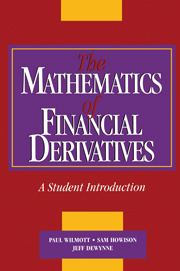8 - Finite-difference Methods
from Part Two - Numerical Methods
Published online by Cambridge University Press: 05 June 2012
Summary
Introduction
Finite-difference methods are a means of obtaining numerical solutions to partial differential equations (as we see in this chapter) and linear complementarity problems (as we see in the following chapter). They constitute a very powerful and flexible technique and, if applied correctly, are capable of generating accurate numerical solutions to all of the models derived in this book, as well as to many other partial differential equations arising in both the physical and financial sciences. Needless to say, in such a brief introduction to the subject as we give here, we can only touch on the basics of finite differences; for more, see Option Pricing. Nevertheless, the underlying ideas generalise in a relatively straightforward manner to many more complicated problems.
As we saw in Chapter 5, once the Black–Scholes equation is reduced to the diffusion equation it is a relatively simple matter to find exact solutions (and then convert these back into financial variables). This is, of course, because the diffusion equation is a far simpler and less cluttered equation than the Black–Scholes equation. For precisely this reason also, it is a much simpler exercise to find numerical solutions of the diffusion equation and then, by a change of variables, to convert these into numerical solutions of the Black–Scholes equation, than it is to solve the Black–Scholes equation itself numerically. In this chapter, therefore, we concentrate on solving the diffusion equation using finite-differences.
Information
- Type
- Chapter
- Information
- The Mathematics of Financial DerivativesA Student Introduction, pp. 135 - 164Publisher: Cambridge University PressPrint publication year: 1995
Accessibility standard: Unknown
Why this information is here
This section outlines the accessibility features of this content - including support for screen readers, full keyboard navigation and high-contrast display options. This may not be relevant for you.Accessibility Information
- 3
- Cited by
